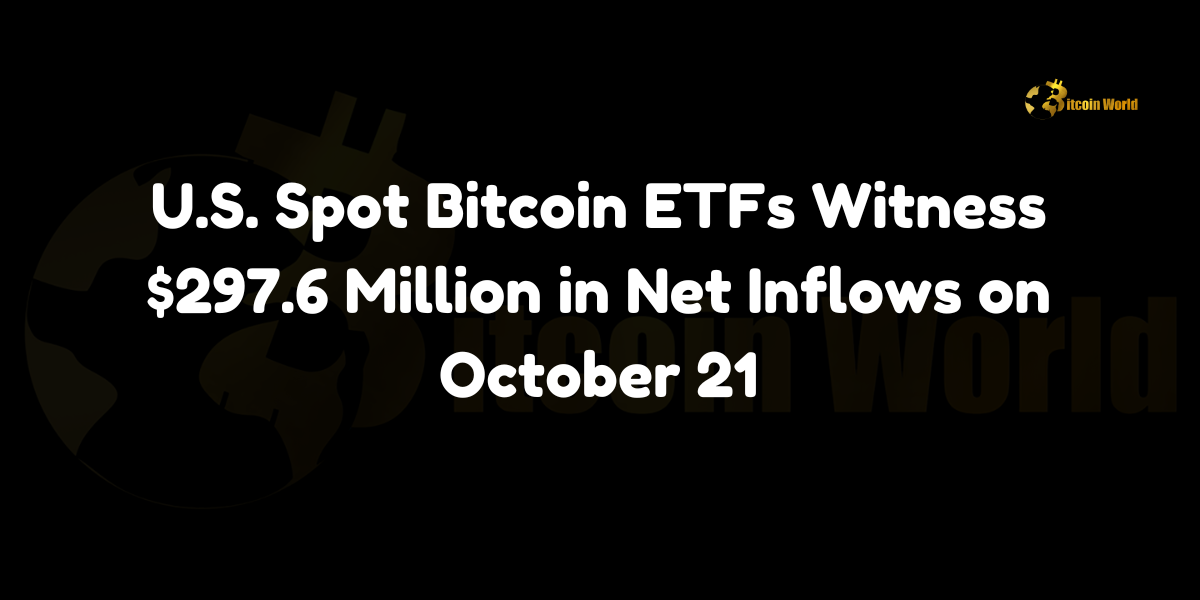US Spot Bitcoin ETFs Witness $297.6 Million in Net Inflows on October 21
On October 21, 2024, U.S. spot Bitcoin Exchange-Traded Funds (ETFs) experienced a combined net inflow of $297.6 million, marking the seventh consecutive day of gains. This surge in investment activity is driven by robust market sentiment and increasing institutional interest, according to data from Farside Investors and Tree News’ Bloomberg data. BlackRock’s IBIT led the inflows with an impressive $332.3 million, followed by Fidelity’s FBTC which added $5.9 million. In contrast, Bitwise’s BITB, VanEck’s HODL, ARK Invest’s ARKB, and Grayscale’s GBTC experienced outflows of $22.1 million, $7.6 million, $6.1 million, and $4.8 million, respectively.
Overview of ETF Inflows
The reported $297.6 million in net inflows signifies a strong investor confidence in U.S. spot Bitcoin ETFs. This influx reflects a growing acceptance and integration of Bitcoin into traditional financial portfolios, driven by factors such as increased regulatory clarity, institutional endorsements, and the maturation of the cryptocurrency market.
Key Highlights
Total Net Inflows: $297.6 million
Leading ETF: BlackRock’s IBIT with $332.3 million
Second Largest Inflow: Fidelity’s FBTC with $5.9 million
Notable Outflows:
Bitwise’s BITB: $22.1 million
VanEck’s HODL: $7.6 million
ARK Invest’s ARKB: $6.1 million
Grayscale’s GBTC: $4.8 million
Data Sources: Farside Investors and Tree News’ Bloomberg data
Breakdown of ETF Performances
BlackRock’s IBIT Dominates Inflows
BlackRock’s IBIT stands out as the primary beneficiary of the net inflows, attracting $332.3 million. This significant investment underscores BlackRock’s influential position in the financial industry and its commitment to offering diversified Bitcoin investment options to its clients.
Fidelity’s FBTC Gains Traction
Fidelity’s FBTC contributed $5.9 million to the inflows, reflecting Fidelity’s reputation for reliability and trustworthiness in the financial sector. The modest yet steady inflow highlights the growing interest in Fidelity’s offerings among investors seeking exposure to Bitcoin.
Contrasting Outflows in Other ETFs
While some ETFs experienced substantial inflows, others faced notable outflows:
Bitwise’s BITB: Shed $22.1 million, possibly due to profit-taking or strategic rebalancing by investors.
VanEck’s HODL: Outflowed $7.6 million, indicating a shift in investor preferences.
ARK Invest’s ARKB: Recorded $6.1 million in outflows, which may reflect portfolio adjustments.
Grayscale’s GBTC: Experienced $4.8 million in outflows, potentially influenced by competitive ETF offerings.
Analysis of Trends
Sustained Growth Over Consecutive Days
The seventh consecutive day of net inflows highlights a persistent upward trend in Bitcoin ETF investments. This sustained growth is indicative of a broader acceptance of Bitcoin as a legitimate asset class within traditional financial frameworks.
Institutional Interest and Market Maturity
The dominance of ETFs like BlackRock’s IBIT and Fidelity’s FBTC suggests that institutional investors are playing a pivotal role in driving market maturity. Their substantial investments not only provide liquidity but also enhance the credibility and stability of the cryptocurrency market.
Impact of Regulatory Developments
Recent regulatory developments have likely contributed to the surge in ETF inflows. Clearer guidelines and approvals for Bitcoin ETFs have reduced uncertainty, encouraging more investors to allocate funds to these financial instruments.
Implications for the Cryptocurrency Market
Increased Liquidity and Market Stability
The substantial inflows into Bitcoin ETFs enhance market liquidity, making it easier for investors to enter and exit positions. Higher liquidity generally leads to more stable prices, reducing volatility and fostering a healthier trading environment.
Enhanced Mainstream Adoption
The growth of spot Bitcoin ETFs signals a broader trend towards mainstream adoption of cryptocurrencies. As more traditional financial institutions embrace Bitcoin, it paves the way for wider acceptance and integration into everyday financial activities.
Diversification of Investment Portfolios
Bitcoin ETFs offer investors a convenient way to gain exposure to Bitcoin without directly holding the cryptocurrency. This facilitates portfolio diversification, allowing investors to balance their assets across different classes and mitigate risks.
Expert Opinions
Dr. Emily Carter, Blockchain Analyst
“The consistent inflow into U.S. spot Bitcoin ETFs underscores the growing confidence in Bitcoin as a legitimate investment vehicle. Institutional backing from firms like BlackRock and Fidelity is crucial for the long-term stability and acceptance of Bitcoin in mainstream finance.”
Mark Thompson, Financial Strategist
“The significant net inflows into Bitcoin ETFs reflect a maturation of the cryptocurrency market. As regulatory landscapes become clearer, we can expect continued institutional interest, which will further drive the growth and stability of Bitcoin as an asset class.”
Sarah Lee, DeFi Researcher
“Bitcoin ETFs are bridging the gap between traditional finance and the decentralized world. This convergence is essential for fostering innovation and expanding the reach of cryptocurrencies to a broader audience of investors.”
Future Outlook
Continued Growth and Diversification
As Bitcoin continues to gain traction, we can anticipate further growth in ETF inflows. Additionally, the diversification of ETF offerings, including those focused on altcoins and other digital assets, will cater to a wider range of investor preferences.
Potential for New ETF Launches
The success of existing Bitcoin ETFs may encourage the launch of new products, including ETFs for other cryptocurrencies and diversified digital asset baskets. This expansion will provide investors with more options to tailor their portfolios according to their risk appetite and investment goals.
Impact of Global Economic Conditions
Global economic conditions, including inflation rates, interest rates, and geopolitical developments, will continue to influence investor behavior and ETF inflows. A stable or bullish economic environment may further boost investment in Bitcoin ETFs.
Conclusion
The $297.6 million in net inflows into U.S. spot Bitcoin ETFs on October 21, 2024, marks a significant milestone in the integration of Bitcoin into mainstream financial markets. Led by BlackRock’s IBIT and supported by Fidelity’s FBTC, the surge in ETF investments reflects strong institutional confidence and the maturation of the cryptocurrency market. While some ETFs experienced outflows, the overall trend points towards increased liquidity, enhanced market stability, and broader adoption of Bitcoin as a legitimate investment asset.
As the cryptocurrency landscape continues to evolve, the role of ETFs in shaping investor sentiment and market dynamics will remain pivotal. Investors and stakeholders should monitor these trends closely, as they offer valuable insights into the future trajectory of Bitcoin and the broader digital asset ecosystem.
To stay updated on the latest developments in cryptocurrency investments and market trends, explore our article on latest news, where we cover significant events and their impact on digital assets.





